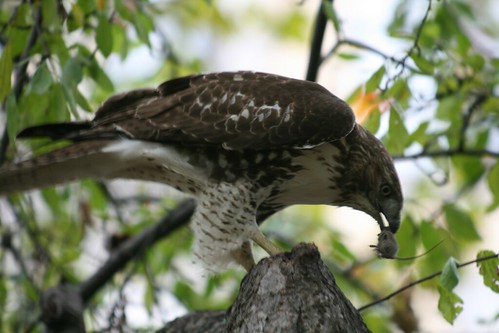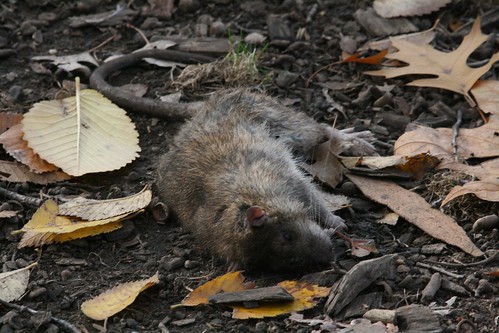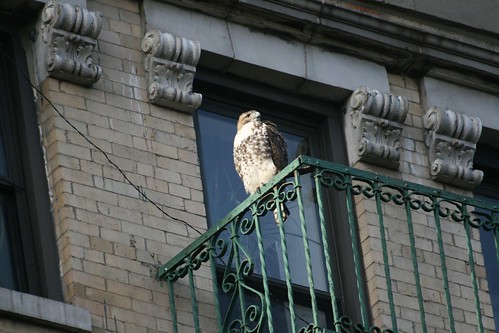The Hawks of New York are dying...
I wrote this story last year. In the interim time, all the hawks I photographed in the East Village have died. Saturating our neighborhoods with poison does not seem to control rats, but does have a profound effect on Urban Raptors. I can't put the blame on the shoulders of city officials alone. We have to change the culture of litter in New York. Setting out on another ecological disaster, such as we saw with the use of DDT, decades ago, seems just not wise in these days where the planet is showing such hard use and wear.
For those who read the quotes attributed to me in the Villager this week, they were not accurate. I did not say hawks were eating the poisons, nor did I repeat the quote from the following article as my own, it was a quote from Francois Portman, and was taken out of context.

Red Tailed Hawk Tomkings Square Park - Photo Lorcan Otway
In the parks of the Lower East Side, packets of Contrac are popping up in flower beds like crocuses. Francois Portmann, a Swiss photographer, told me where to find packets of Contrac, a second generation anticoagulant rodenticide, lying on the ground in parks throughout the Lower East Side. Each packet is found in a place often frequented by the pair of red tail hawks which have so delighted the people of the Village, and increased the number of "birders" coming to our neighborhood. Bird watching has become a local passion for many in the neighborhood. "I will be over at Union Square park," says Francois. "There is a Scott's Oriole there, a bird from Arizona/Mexico that has nothing to do with here, hordes of birders from the tri-state area came by through the weekend to see it." In Union Square. I find Dennis Edge, a local bird photographer, explaining the habits of local birds to knots of people. This morning, Dennis is surrounded by people with binoculars, or simply staring into the brush." There, among the large green leaves is the Scott's Oriole, a brilliant yellow bird, not found in New York, a tourist perhaps. Directly above, on a fire escape, one of our yearling red tailed hawks. Hawks are now common on every street in the Lower East Side.
There is danger for the hawks. In Stuyvesant Park, right in front of Friend's School, where young children play, a packet of Contrac lies in easy reach over a low railing. "It’s not only about the birds....this stuff is on the ground as you can clearly see. What if a dog or worst, a kid picks it up, or someone with bad intentions?" Francois asks. Contrac's active ingredient is Bromadiolone. a second-generation anticoagulant poison. It kills by causing internal hemorrhaging, usually after only a single ingestion. It can cause the death of any animal which feeds on a dead rodent which has ingested a lethal dose of the poison. In the early winter, Parks Department spokesperson Jesslyn Tiano stated that Parks follows "the Department of Health's rodenticide recommendations and primarily use products containing Bromadiolone, which has a lower secondary risk value than Difethialone."

Red Tailed Hawk easts a mouse in Tompkins Square Park - Photo Lorcan Otway
The Zoological Society of London publishes a "good practice guide for landowners in England" called "Helping Red Kites". Like the red tailed hawk, the red kite is a raptor which feeds on rodents. In this guide, it states that birds of prey are "particularly susceptible to secondary poisoning as they will eat poisoned rodents and ingest the poisons they contain. These poisons may kill [the raptor] immediately, or they may accumulate in the body and cause eventual death." The article specifically names Bromadiolone. Parks’ Deputy Commissioner Liam Kavanagh states that they, "suspend baiting when there is nesting or a significant level of daily activity by predatory birds. Baiting is still suspended at Tompkins Square Park, but there and in other places, if rodent activity spiked and other measures were ineffective, we would resume some level of pesticide use."

However, there seems to be a gap in the sighting of predatory birds and action to stop poison programs. "There must be something we can do, call the Mayor's office, the city council?" says Dennis Edge, his voice tinged with concern for the birds which he cares so much about. He hopes people will understand the danger to the birds, and value what these birds mean to so many in the city.
Deputy Commissioner Kavanagh explains that, "Parks works with the Department of Health on rodent control strategies and follows Integrated Pest Management principles that include monitoring pest levels, eliminating food sources and harborage and judicious use of chemical controls that have the least possible risk to people, property, domestic animals and urban wildlife. There is no single perfect chemical control, but the materials we use, in combination with the other principles allow for safe and effective pest control. We do not use pesticides that pose the greatest overall potential risk to birds or mammals. We use low hazard bait formulations and application techniques when applying pesticides in parks and consider other environmental factors when deciding on the most appropriate control measures" Quintox is not an anticoagulant, and there is no antidote. The toxicant mobilizes calcium from the bones into the bloodstream producing heart failure. Quintox's state that "Since birds don't have bone marrow this product is the best choice for use around birds of prey (Eagles and Hawks)." Deputy Commissioner Kavanagh points out that, "both bromadiolone (Contrac) and cholecalciferol (Quintox) are categorized as having a low to moderate primary risk to birds. Cholecalciferol has a lower secondary risk rating for birds, but poses a different problem for mammals that are found in parks far more frequently and in much higher numbers than predatory birds. There is no antidote for cholecalciferol, as there is for bromadiolone, and accidental acute poisoning from cholecalciferol in dogs, cats and squirrels and other mammals can result in prolonged and especially painful deaths. Kavanaugh states that they do suspend baiting programs in parks where predatory birds are nesting or regularly visiting. However, these birds are seen constantly hunting on all the side streets of the Lower East Side.

Red Tailed Hawk, Fire escape - Photo Lorcan Otway
Maggie Rufo, volunteer Assistant Director of the Hungry Owl (Hungryowl.org) project holds that Quintox's statement that birds do not have bone marrow is not accurate. "Most of the bones in a bird's body are 'hollow' but not all. They do have some bones with marrow, but not nearly as many as mammals . If Quintox stops calcium absorption in rats and mice, both mammals, does it do so to other mammals like raccoons, foxes, your pet cat or dog? If so, then it too, is not really safe for use around animals."
Children do have bone marrow, Even in "tamper proof" bait stations, the safety of these poisons is only as effective as the care with which it is applied. The sight of poison packets in easy reach in our parks leads me to ask if this is the best solution? Rufo questions the reliability of the tests which are used to establish the safety of the products. An example of how secondary hazard evaluation of poisons is carried out as follows. A laboratory gave fifty-ppm bromadiolone oat bait to California ground squirrels. After they died, they were fed to coyotes. Each coyote ate one a day for five days. Some sickened but none died. However, in nature, the primary target animal seldom eats only a fifty percent lethal amount. As reported in the Villager, experts explain that in single dose anticoagulant poisons, the target animal often eats many times the lethal dose, which is why animals such as mountain lions, which feed on the target animal die. According to Maggie Rufo, In San Francisco, exclusion and sanitation are used as alternative solutions.
Exclusion, the sealing off of buildings, is hard in New York City. In San Francisco, a big problem was uncovered trash cans in the parks and the fact that they were not emptied frequently enough. Another very big contributor to the problem were people who fed animals in the park, feeding birds and squirrels is in effect feeding rats and mice as well
In the past, cities hired people who trained terriers, dogs which provided efficient rat control without costing us hawks, and owls, or dogs and cats. Even today, dogs are used for environmentally sensitive rodent control. In Australia, Michael Bloch is the author and owner of Green Living Tips.com, an online resource for earth friendly tips. (http://www.greenlivingtips.com/) He states that, "Fox/Jack Russell terriers are some of the best mousers and ratters around; far superior to cats. Terriers do not play with rodents like cats will, they kill them extraordinarily quickly and move on to the next one. I've seen old newsreel footage of mouse plagues in Australia where terriers were let loose in barns and the numbers of rodents they dispatched within a very short space of time is incredible. Unlike cats, terriers can also be trained very easily to discriminate between animals. . Our dogs will allow birds to eat directly from their food bowls; but any mouse that may approach is very quickly dealt with." Perhaps nature is a good teacher to look to in learning balance in New York's environment.


1 Comments:
is it such a bad thing to stop using rodenticides for a while,there are other ways to get rid of rodents such as the humble trap, and its no more time comsuming than indiscrimantly laying poison baits, providing you make a plan and work to that plan no matter what,you can put down (covered) traps just as you put down baits, but out of sight is out of mind! and its better to have a trap hidden than in the open anyway, i have had great results with traps and you can get a better body count,more that you can with poison baits..
Post a Comment
<< Home